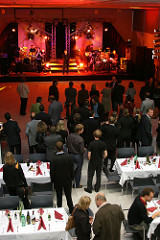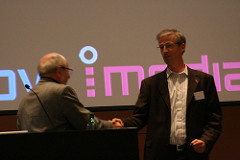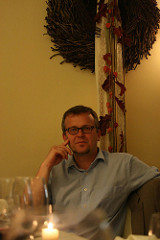As blogged before, I attended the Triple-I conference 2007.
Summing it up:
- There are pictures online from me, bblfish (Henry Story), and others.
- The four Keynotes were interesting, and gave insights both from scientific view (innovation, trends)
- as from the corporate view (buzzwords, trends, where to invest)
- DFKI contribute quite much in the field of Knowledge Management, we had several papers published on: the Nepomuk Social Semantic Desktop (with many co-authors), the PIMO personal information model, the ConTag tagging system, Philosophy and Cognitive aspects of Semantic Desktops, and E-Learning
- Martin Memmel also blogged about his trip to Graz
Papers were I contributed were:
- Danish Nadeem, Leo Sauermann: From Philosophy and Mental-Models to Semantic Desktop research: Theoretical Overview.
- Benjamin Adrian, Leo Sauermann, Thomas Roth-Berghofer: ConTag: A semantic tag recommendation system
- Leo Sauermann, Ludger van Elst, Andreas Dengel: PIMO – a Framework for Representing Personal Information Models.
- Tudor Groza, Siegfried Handschuh, Knud Moeller, Gunnar AAstrand Grimnes, Leo Sauermann, Enrico Minack, Cedric Mesnage, Mehdi Jazayeri, Gerald Reif, Rosa Gudjonsdottir: The NEPOMUK Project – On the way to the Social Semantic Desktop.
The Triple-I is balanced between science, technology fair with customer contacts, and social networking event. For example, enjoy the social event:
Klaus Tochtermann and the Know-Center are the main organizers, the newly re-branded Semantic Web Company assisted, as did Salzburg Research. Hermann Maurer was omnipresent, as scientific father of many innovations.
Here is a short summary of the conference, extending my previous post.
Triple-I was this year not-so-organized during the paper submission phase (they changed paper length once) but on-site, its very well organized. The keynotes are at 09:30, leaving enough time to get your morning coffee. Between the sessions are long 1h breaks to knit your social network. I met many old and new aquaintances and friends. Fine conference.
At the evening of the first day, there was a welcome reception at Minoritensaal.
Second day I presented a haptic personal semantic network, a birthday present from my university friends:
In the afternoon of Thursday, the second day, the FFG and the Innovation Relay Centre Austria organised an International Cooperation Event. I represented DFKI at this Event and revived contacts with old partners and found new possible partners, alltogether a speed dating with 10 people, 20 minutes each. Exhausting, but worth it.
Friday Evening, Andreas Blumauer organized a dinner I was very happy to attend.
Here is what they say about themselves:
The TRIPLE-I Conference series is a joint venture of the conferences I-KNOW, I-MEDIA and I-SEMANTICS. TRIPLE-I reflects the increasing importance and convergence of knowledge management, new media technologies and semantic systems. This unique concept aims at bridging the gaps between the various communities and their technology fields.
Building upon the reputation of the premium conference series I-KNOW and SEMANTICS the upcoming event addresses representatives from academia, industry and public administrations. TRIPLE-I will offer its participants a unique platform either to present latest and leading edge developments or to catch up with the developments of most innovative IT technologies, content applications, business models and emerging market opportunities.






 .
.